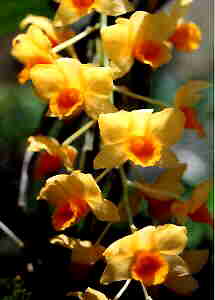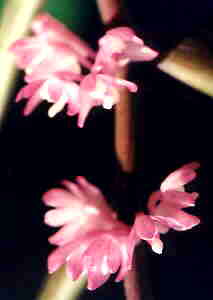|
|
|
CONTACT US
Click Here! |
| This site is best viewed with a screen resolution of 800 X 600 at high colour settings |
|
Flask list
Acacallis-Ancistrochilus Angraecum-Aspasia Barkeria-Broughtonia Bulbophyllum Capanemia-Catasetum Cattleya Cattleyopsis-Cycnoch, Cymbidium-Cyrtorchis Dendrobium-Dossinia Encyclia-Eulophiella Galeandra-Kalopternix Laelia-Lycaste Macodes-Nephalaphyll, Odontogloss,-Oncidium Paphiopedilum-Psychilis Rangaeris-Stenocoryne Tainia-Zygopetalum |
|
Plant list
Acampe-Bulbophyllum Cattleya-Dossinia Encyclia-Promeaea Renanthera-Vanda |

BP SPECIES NEWSLETTER January 2002July00 Aug Sept Oct Nov Dec Jan01 Feb Mar April MayJune July August September October November December
Photos in this issue: Dendrobium Griffithianum above, Trichoglottis latisepala, Trichoglottis loheriana, Trichoglottis retusaDo you know any orchid growers who may like to receive this newsletter? Why not forward this email to them now!A b&w printed copy of this Newsletter can be mailed each month if you send 12 Australian stamps or 12 International reply coupons to Burleigh Park Orchid Nursery, 54 Hammond Way, Thuringowa, Australia 4815.Items in this newsletter may be reproduced provided source acknowledged.We commend "Orchids Online Web Design" for the excellent work on our web site and this Newsletter.For information or prices click here or email Steve at steve@orchidsonline.com........A. What's New in flask.Gongora superflua. The Punch and Judy orchid. This genus has a complex labellum, and with the flower turned on its side, the labellum ( Punch) appears to have outstretched arms to embrace the column ( Judy). Best grown in a basket in a media that will stay damp, as these plants do not like to dry out. Mostly warm growers, they will need maximum sunlight short of leaf burn to flower well.Dendrobium Griffithianum. A very showy species with large bunches of yellow flowers. Grows and flowers much like a Dend farmerii with all yellow flowers . Small pot or basket culture, grow on the dry side during the dormant winter and lots of water and fertiliser when new growths appear. Dendrobium bigibbum Superbum. The rich purple phalaenanthe dendrobium from North Queensland, Australia. The Cooktown orchid produces long spikes of showy, well shaped purple flowers in autumn. Dormancy in winter is essential, when the plants should be keep almost completely dry, with just sufficient watering to prevent shrivelling. A warm grower, needs a small pot with a well drained media. Dendrobium bigibbum var bigibbum alba x alba. From the top of Cape York, Australia. This has a flower similar to the Cooktown orchid, but with a much more rounded flower, and is grown the same way. Two alba clones crossed, clear sparkling white flowers with a touch of green in the throat of the lip. The Nursery raised plants are much larger and more robust than the original species. Trichoglottis luchensis. Previously listed as T. ionosma "Formosa", the correct name has been applied. This is similar to T. ionosma, but with a different labellum, and is grown the same way. B. What's ready to replate NOW.Gongora chocoensis. A Punch and Judy orchid with redbrown and white flowers. Best grown in a hanging basket, for the long pendulous spikes.Ionopsis paniculatus. A minature Oncidium type plant, best grown on a slab of treefern if available or a piece of cork with extra water. It produces a panicle of pale pink to lilac flowers, the lip with darker stripes. Intermediate grower, dry in winter, and fairly shady conditions suit. Dendrobium atroviolaceum is a showy small growing Latourea Dendrobium from New Guinea. The flowers are in clusters, cream to yellow, somewhat spotted redbrown, the lip violet purple. Best grown in a small pot or basket in a media that will stay damp but not wet. Several seedlings grown together in a small pot will produce an attractive small growing specimen. Phragmipedium lindenii "Gernot". The South American slipper orchid. with large green flowers and long petals. Best grown as almost a bog plant, with a media that wont dry out. Some growers recommend standing the pot in a saucer of water. Phalaenopsis sanderiana. A large growing species with dark green leaves, dark purple leaves underneath. The flowers are pale to dark pink, shaped much like P amabilis. A warm grower, it requires a shallow pot or basket, a well drained media. and a shady spot. Cymbidium bicolor. Allied to C. aliofolium etc, this is a robust grower with yellow flowers striped red. Best grown in a basket to accomodate the long pendulous many flowered spikes, it is a good outdoors garden subject in warm to intermediate climates. C. What's new in Plants. Trichoglottis brachiata. Near flowering size plants. See
"Trichoglottis" below.
Trichoglottis brachiata. Near flowering size plants. See
"Trichoglottis" below.
Trichoglottis fasciata. Flowering size plants. Trichoglottis ionosma. Flowering size plants, previously listed as T cunelabris. Trichoglottis loheriana. A slow, robust grower,these are developing into sturdy seedlings in 80mm basket pots. Trichoglottis luzonense. Near flowering size plants. Trichoglottis philippinense. Flowering size plants. Trichoglottis retusa. A rarely seens species, a few flowering size plants are ready for repot. Trichoglottis tomentosa. Flowering size. Trichoglottis wenzellii. Flowering size plants. . All listed plants are Nursery raised from seed. For culture see "Trichoglottis" below. Pomatocalpa thailandense. Very similar in growth and culture to the Trichoglottis. This species grows easily and produces an erect branched spike of many yellow and brown flowers in profusion. TOP D. Culture
|
Designed and maintained by
Orchids Online Web Design
© All rights reserved.

 There are basically two types of Trichoglottis, one has
thin pendulous stems with small flowers along the stem and includes Trichoglottis
australiensis ( Australia) and the occasionally seen Trichoglottis
latisepala ( usually identified as T. rosea because of the coloured
flowers, photo left) from the Philippines.
There are basically two types of Trichoglottis, one has
thin pendulous stems with small flowers along the stem and includes Trichoglottis
australiensis ( Australia) and the occasionally seen Trichoglottis
latisepala ( usually identified as T. rosea because of the coloured
flowers, photo left) from the Philippines.
.jpg) T. brachiata, fasciata,
philippinense, tomentosa, wenzellii and retusa are climbers,
requiring a piece of treefern, cork or old wooden paling to clamber up.
T. brachiata, fasciata,
philippinense, tomentosa, wenzellii and retusa are climbers,
requiring a piece of treefern, cork or old wooden paling to clamber up.